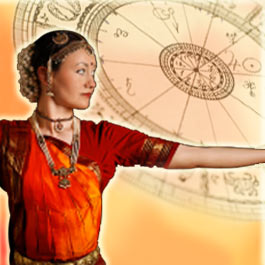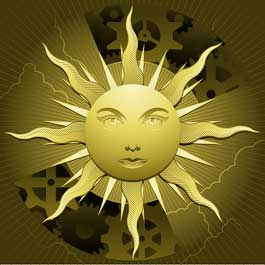Why Is Vedic Astrology Different?
By Carol Allen

There are many differences between Vedic Astrology and the more commonly known system practiced here in the West – Tropical Astrology, also known as Western Astrology.
Vedic Astrology has been practiced for many thousands of years. The earliest writings can be found in the Vedas – the ancient spiritual texts of the Hindus and the oldest books in existence, written 5,000 – 8,000 years ago. Its Indian name is Jyotish, which means “science of light” because it is the science of observing the celestial bodies that reflect their energy and light upon the
Earth, therefore influencing the course of human events.
Western Astrology: It’s All About The Sun
Western Astrology was devised by the Greeks and the Babylonians around 2,000 to 3,000 years ago. They believed that, since the Sun is the center of the Solar System, the relationship of the Earth to the Sun is most important. It utilizes the Tropical Zodiac, which measures the relationship of the Sun to the Earth’s tropics (the Tropic of Cancer and the Tropic of Capricorn).
On or around March 22 of each year marks the start of Spring, the Vernal Equinox in which we have day and night of equal lengths. This is astrologically the true beginning of a new year. (One of the Roman emperors made January 1 the beginning of the calendar year – it means nothing astrologically.) Because it is the astrological new year, Western astrology dictates that the first sign, Aries, begin around the Vernal Equinox and the other signs follow in consecutive order.
Vedic Astrology: It’s In The Stars
Vedic Astrology does not measure when the signs begin and end in this way. It utilizes the Sidereal or Stellar Zodiac, which looks to the fixed stars of the constellations to determine this. Sidereal means “pertaining to the stars.”
According to Vedic astrology, looking at the relationship of the Earth to the Sun is not an accurate approach to measuring the signs due to what’s referred to as the “precession of the equinoxes.” The Earth is spinning like a top in one direction but wobbling slightly in the other. This causes the equinoxes to precede about 50 seconds every year. What this means in simple, layman’s terms is that every 72 years, we lose an entire day in our revolution. Therefore, every 72 years, the signs must shift backward by a day to remain astronomically literal.
“Thus, most people are the Sun sign prior to the sign they have always believed. It shifts the whole chart backward 24 degrees, often changing not only the Sun sign, but the rising sign and Moon sign, as well as the positions of all the planets in the chart.”
Enter Astronomy
The Western system does not adjust for this. Thus, the astrology that is predominantly practiced in Western Civilizations is no longer astronomically observable. When a Western astrologer says, “Venus in Sagittarius,” you can look at night with your naked eye at the star group Sagittarius, and Venus will not be there – it will be one sign back in Scorpio. This is a major reason astronomers do not believe in astrology.
The Vedic system, however, does adjust for the precession of the equinoxes. When Western Astrology was devised, the two systems had the same dates for the Sun signs. Over the centuries, they have drifted apart by around 25 days.
Thus, most people are the Sun sign prior to the sign they have always believed. It shifts the whole chart backward 24 degrees, often changing not only the Sun sign, but the rising sign and Moon sign, as well as the positions of all the planets in the chart.
Isn’t that incredible? It means that if you’ve ever shunned a Scorpio because you thought he might be a spy, or thought a guy was too blunt because he was a Sagittarius… you were dealing with a completely different sign! Poor guy…

Looking To The Future
One of the most exciting tools of Vedic Astrology is the use of “planetary periods” of influence. The periods are incredibly predictive. By looking to that planet in the chart – its sign, house, aspects, house lordship, conjunctions, and strength – one can tell very specifically what a person can expect to experience during that planetary period. Each major period is then broken down into sub-periods lasting one to three years, which then adds another layer of prediction.
It is incredibly exciting! They reveal very clearly why someone’s career takes off or limps along at different times, when an individual can expect to have good or bad health, why they marry when they do, when they will have or have had children, etc.
I hope this is starting to explain why you should never judge someone based on just their sign and why Vedic astrology is such a powerful tool in looking at the whole person – him, you, and how you two fit together.
This is why I’m so passionate about Vedic Astrology and why I wrote my eBook Love Is In The Stars. In it, I debunk the common myths about astrology and tell you why they might have been getting in the way of your love life.
I’ll also tell you about the secrets only astrology can reveal about the kind of man you’re truly compatible with and, just as importantly, I’ll give you practical, step-by-step advice to help you make the most of your romantic destiny… with any man of ANY sign.
Download your copy here: Love Is In The Stars eBook
Compatibility Report: Is He The Right Man For You?
Get Detailed Insights Into Your Relationship, and Learn:

- If your love will last, or fizzle fast
- If your relationship brings misfortune and obstacles
- If your temperaments match for fun and friendship
- How you will feel about each other in the long term